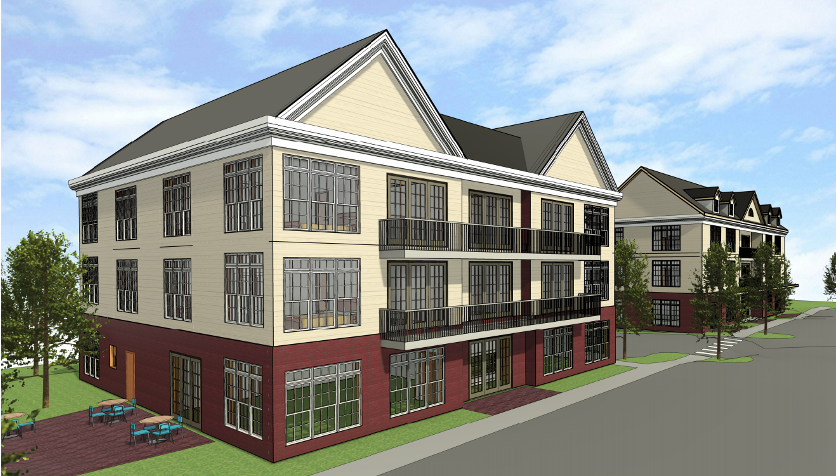More Pipes, Fewer People
How land we could use for homes and shops gets eaten up by septic fields in small-town Vermont.
Hey — Jonah here.
Welcome back to Brick + Mortar, where I share stories on developing real estate at Village Ventures in rural Vermont.

Septic.
Everyone loves talking about septic, right?
No? Well, tough. It’s on the agenda again.
I wrote about it last year and, honestly, I think it’s going to become an annual tradition—because it’s a recurring obstacle for rural infill development.
Most of what we build is in Fairlee, Vermont, where we have town water but no town sewer.
Thankfully, the town is working on assessing the feasibility of a municipal system. But, until then, every single project requires private septic.
I’ve shared this slide before, but it’s worth repeating—each of the five projects below has its own dedicated septic system.
Collectively, they take up about 1.5 acres (60,000 square feet!) of land.
Prime land.
Downtown land.
Land that could be used for more housing, small businesses, or anything else our town needs to grow.
Just to put it in perspective:
The septic systems for these five projects take up more land than the wastewater treatment plant serving the entire town of Bradford, which is four times bigger than Fairlee.
Let that sink in.
In the same amount of land our five septic systems use, we could fit a full town-wide system to serve 100x the number of people.
Of course, funding a municipal system is a whole separate can of worms (and a major lift). But it’s still worth pointing out the land-use inefficiencies that come from needing private septic on every new project.
Ok, so we all understand the problem.
Here’s the latest case study that has us scratching our heads:
We’re in pre-development on a 26-unit mixed-use project—nicknamed The Denison—on a half-acre site right in Fairlee’s village center.
Half an acre isn’t much land to work with. Especially when you’re trying to max out density:
First-floor retail
Two stories of housing above
Parking
When you add it all up, there’s not much land left for septic.
In fact, there’s none.
The site plan makes that painfully obvious.

So, we’re left with two options:
Sacrifice a building (and leave a big, awkward gap along Main Street), or
Find a way to get septic offsite
We’re working on the second option.
Luckily, two of our partners own vacant land across the street. The current plan is to bore under Main Street (a state highway, no big deal 😅), cross a second street, and install a new septic system there.

But that brings two big new headaches:
1. Cost
Between boring under the road, ripping it up on the other side, installing a pump station, adding a pre-treatment system, and all the other pieces—you’re easily looking at $100k+ just for septic.
2. Limits on Use
If the system is designed for more than 6,500 gallons per day, it bumps us into a new regulatory category (an indirect discharge system), which means even more design, compliance, and cost.
To stay under that threshold, we have to limit who can rent the retail space—and drastically reduce the size and seats of restaurants or bakeries (which we need!).
Beyond just cost and compliance, there’s the added coordination headache:
Working with the state (for boring under the highway)
Working with the town (for trenching on the far side)
Working with private landowners (for burying lines across someone else’s land)
Negotiating to purchase or control a separate piece of land just for the septic system
All of this just to solve something a town sewer system could fix overnight.
Imagine what Fairlee could unlock if all the land currently tied up in private septic could be repurposed for housing, ADUs, retail, and public spaces.
Imagine the momentum if septic systems weren’t dictating how much housing we could build downtown.
To be clear: this isn’t a criticism of Fairlee leadership.
They get it. They’re working on it.
This is just a firsthand look at one of the biggest obstacles we run into as developers in rural Vermont.
Anyway—that’s this year’s septic rant. Stay tuned for Episode 3 next spring.
Until next time.
— Jonah 🧱
P.S. Want to connect? Find me on LinkedIn.






Many years ago, Piermont installed a communal septic system for a portion of its village where the lots were too small to support individual septic systems. Based on that experience, it won’t be easy politically to install a sewage treatment plant in Fairlee. Everyone with a currently working septic system will oppose the idea. Everyone outside the village will oppose it, because they don’t need it. Piermont got its system because there was a group of existing homes that needed it, a benefactor donated the required land, state grants were available, and operational costs are paid only by the users.
I would be really interested in understanding the business model for a public sewer system. Without a central system, this type of density, let alone development, does not make any sense.